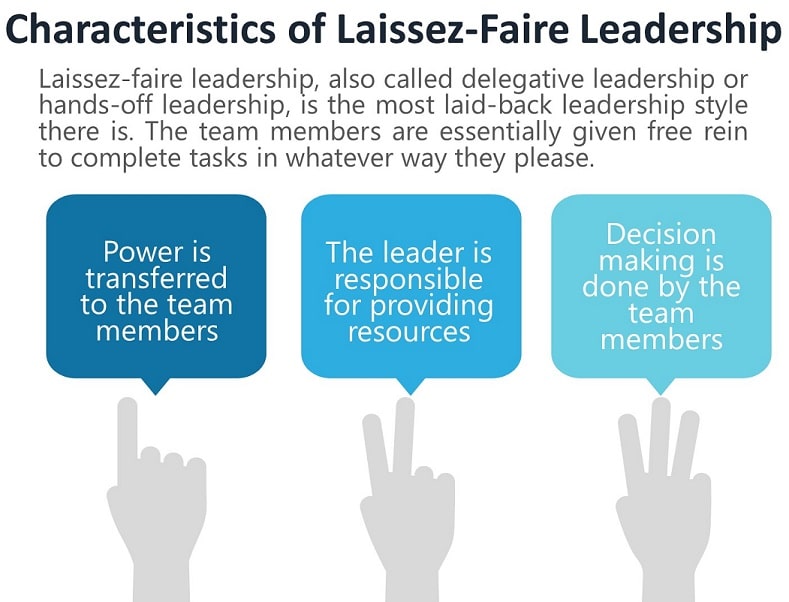I have seen plenty of laissez-faire leadership during my career as a CEO. Some laissez-faire leaders have used the style intentionally, but most have used it simply due to a lack of engagement. Laissez-faire leadership is often associated with leaders who are lazy, uninterested, and uninspiring. Learn more to identify laissez-faire leaders around you and avoid using the laissez-faire leadership style yourself.
Laissez-faire leadership is a hands-off leadership approach where team members make all the decisions. Laissez-faire leadership leads to low productivity and a perception of a disengaged leader but can work in skilled, capable, and self-motivated teams.
This article will explain the concept of laissez-faire leadership, its pros and cons, how to use it, and some reflections from my career. Try our Lewin leadership styles test (new tab) to see if you are an autocratic, democratic, or laissez-faire leader. I also suggest you consider buying my book Leadership Styles Classics: Autocratic, Democratic and Laissez-Faire (Amazon)
Contents
- What is Laissez-Faire leadership?
- The Characteristics and Qualities of Laissez-Faire leadership?
- What are the pros and cons of Laissez-Faire leadership?
- Is Laissez-Faire Leadership Effective?
- How can you be an effective laissez-faire leader?
- My experience of Laissez-Faire leadership
- Famous Laissez-Faire Leaders
- History of Laissez-Faire
- Suggested Reading
- References on Laissez-Faire Leadership
What is Laissez-Faire leadership?
In laissez-faire leadership, only minimal guidance is provided by the leader, and the team members make all the decisions. Laissez-faire leadership was first defined as one of the Lewin leadership styles, together with democratic leadership and autocratic leadership. Laissez-faire is also part of the Full Range Leadership model together with transformational and transactional leadership, a more modern and better framework than the Lewin styles.
Laissez-faire is a French word that means “leave alone”. Although the bolded definition of Laissez-Faire leadership above still makes it seem like a leadership style that is used on purpose, but that does not have to be the case. According to a study concerning Laissez-faire and trust, there are some worse definitions of the Laissez-Faire leadership style. How about “the absence of leadership”[2] or “lack of presence” or even “zero leadership”. A leader that doesn’t lead defeats the whole purpose of being a leader in the first place.
The Characteristics and Qualities of Laissez-Faire leadership?
The following characteristics of laissez-faire leadership do not necessarily say anything about the intention behind them. In some cases, it might be deliberate, but according to the more “zero leadership” type definition of Laissez-Faire, it can also be unintentional behavior on the leader’s part. Each of the characteristics is described in more detail below the image. This hands-off approach makes it radically different compared to autocratic leadership.

1. Power is transferred to the team members
Team members are deemed experts in their fields and the leader trusts them to carry out their roles correctly. However, the leader is still the head of the team and accepts full responsibility for the team’s decisions and actions. In other words, the leader still shoulders the responsibility although team members act independently. Not all leaders can handle being this trusting.
2. The leader remains responsible for providing resources
All leaders are expected to provide resources for their teams. However, a laissez-faire leader’s role is relegated almost exclusively to that function. The leader doesn’t pretend to know what the team needs, and the team isn’t forced to make do with whatever is provided. Instead, the team tells the leader exactly what they need, and the leader either uses his or her resourcefulness to find ways to use what the organization already has or quickly identifies where the resources can be procured. Again, in the unintentional version of Laissez-Faire leadership, I doubt the leader will truly handle the resources needs.
3. All decision-making is left to the team
Team members essentially lead themselves. There is no deferral to the leader for decisions to be made. Therefore, decisions are often made quickly and depend solely on the team member’s level of expertise. Team members are expected to solve problems on their own. A better approach would be Democratic leadership which involves the team making decisions together with the leader.
You can read more about the overall framework here: The Kurt Lewin Leadership Styles, or continue reading for the advantages and disadvantages of laissez-faire. Try our Lewin leadership styles test (new tab) to see if you are an autocratic, democratic, or laissez-faire leader.
What are the pros and cons of Laissez-Faire leadership?
As with all leadership styles, the laissez-faire style has its advantages and disadvantages – as if being the least productive leadership style is not enough.
The Advantages of the Laissez-Faire Leadership Style
Here is a list of the pros of the Laissez-Faire Leadership style:
- 1. Increased autonomy
- 2. Team members have creative freedom
- 3. The retention rate can increase
- 4. Faster decision-making
Read more about each of these advantages in detail in our separate post: Laissez-Faire Leadership Advantages.
The Disadvantages of the Laissez-Faire Leadership Style
Here is a list of the cons of the Laissez-Faire Leadership style:
- 1. Teams that need consistent guidance fall apart
- 2. The leader is viewed as uncaring and absent
- 3. Productivity decreases
- 4. Team members are confused about their roles
- 5. Lack of direction and communication
You can read more details about the disadvantages and their consequences in our article on Laissez-Faire Leadership Disadvantages.

Is Laissez-Faire Leadership Effective?
Kurt Lewin and his team are credited with having conceptualized laissez-faire leadership in 1939. The Lewin leadership experiments revealed that people are least productive under laissez-faire leadership. Let me repeat that: Their research showed that people are least productive under laissez-faire leadership. However, the experiments they executed were on groups of children. Perhaps more can be expected from an adult group led by the laissez-faire style? (See my criticism of the Lewin leadership styles.) Continue reading about how to become effective at Laissez-Faire leadership or watch our video on the Kurt Lewin Leadership Styles, right here:
How can you be an effective laissez-faire leader?
Laissez-faire leadership can work in creative environments, although you are better off using alternative leadership styles. If you do implement laissez-faire leadership, make sure to cover the following areas. (Find out if you have laissez-faire leadership tendencies here: Leadership Styles Test.)
To be an effective laissez-faire leader, you need to cover the following crucial areas:
- Bring the right talent together
- Know how to secure the right resources and support efficiently
- Empower the team, do not micro-manage
- Ensure accountability
- Ensure that there is a proper vision and concrete goals
More information on these five areas can be found in our article on “How can you be an effective laissez-faire leader“. Last but not least: don’t work too hard at becoming effective at one of the most ineffective leadership styles. Consider better and more modern situational approaches to leadership, such as the situational leadership model, leadership styles by Goleman, transformational or transactional leadership, etc. You can read about them and many others in our portal: leadership styles. Try our Lewin leadership styles test (new tab) to see if you are an autocratic, democratic, or laissez-faire leader.
My experience of Laissez-Faire leadership
I have never deployed this leadership style myself, either willingly or unwillingly. I have always felt way too inspired in my leadership roles to simply sit back and stop caring essentially – because that is what Laissez-Faire is about to me. I can not imagine why someone would purposefully select to deploy a Laissez-Faire leadership style when there are so many others that can give great benefit when used with intent.
Although several definitions of Laissez-Faire exist and have been presented above, I tend to lean towards the more unintentional definition, i.e. “zero leadership” and kind of ignoring your responsibility as a leader and simply sit back and let things play out. The reason for this is that I simply cannot understand how someone would want to do be a laissez-faire leader on purpose. What is your contribution then? A leader who doesn’t lead? Read my separate article on Laissez-faire leadership examples, which includes some experiences from my career and some famous leaders in history.
Don’t get me wrong, there are numerous reasons not to micromanage, to empower your team, and to ensure the team members are strong enough to handle things themselves, but there are other ways of reaching this and still actively contributing as a leader. Perhaps coaching leadership or servant leadership could be deployed for instance? (Available here: leadership styles.) Even if I trust my team members’ decisions more than my own, I could still be useful for vision, inspiration, instilling a team spirit, encouraging the team members to talk to each other, etc. – none of which I see in the laissez-faire leadership style.
Famous Laissez-Faire Leaders
Famous Laissez-Faire Leaders:
- Steve Jobs
- Queen Victoria
- Ronald Reagan
- Warren Buffet
You can read more about these people in our article here: Famous Laissez-Faire Leaders.
History of Laissez-Faire
Laissez-faire is a French word that means “leave alone”. It has been linked to a pivotal point in King Louis XIV’s reign. His controller of finance, Jean-Baptiste Colbert, tried to determine how the government could strengthen commerce by assisting industrialists. He consulted with businessman Le Gendre who simply said, “Laissez-faire” which was interpreted in that context to mean “Let us do what we want to do.” It should be noted, however, that laissez-faire economics is different from laissez-faire leadership but the fundamental premise of each is that people do what they want.
Suggested Reading
For starters, I would like to recommend my book Leadership Styles Classics: Autocratic, Democratic and Laissez-Faire (Amazon)
Learn more about the Lewin leadership styles or the Lewin leadership experiments. You can also read some of my criticism of the Lewin styles. Laissez-faire is also part of the Full Range Leadership model together with transformational and transactional leadership, a more modern and better framework. Try our Lewin leadership styles test (new tab) to see if you are an autocratic, democratic, or laissez-faire leader.
If you want to understand this style compared to another, you can read our comparison article: Autocratic leadership compared to Laissez-Faire leadership.
Most importantly, I suggest you improve your knowledge and skills in leadership further by visiting our portal on leadership styles. It contains information about more than 25 different styles from a dozen important theoretical frameworks.
References on Laissez-Faire Leadership
https://online.stu.edu/articles/education/what-is-laissezfaire-leadership.aspx
https://cals.arizona.edu/classes/aed301/laissez
[1] https://www.researchgate.net/publication/320283218_Laissez-Faire_leaders_and_organizations_how_does_Laissez-Faire_leader_erode_the_trust_in_organizations
[2] “Laissez-faire leaders and organizations: How does laissez-faire leader erode the trust in organizations?” refer to Bass & Avolio




